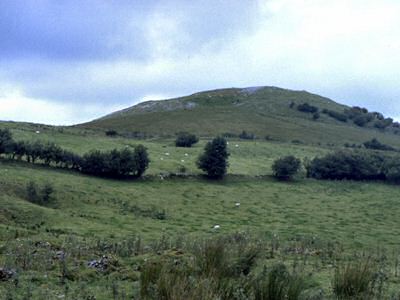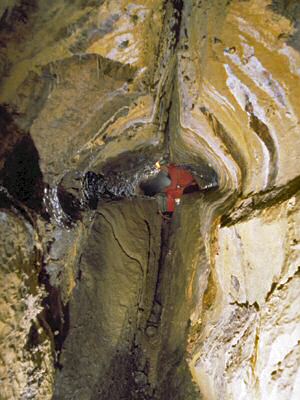Earth Science Conservation Review
| Marlbank-Cuilcagh Mountain Region; Tullyhona, Brookfield and Trien | Fermanagh |
| Site Type: | Karst |
| Site Status: | ASSI |
| Council area: | Fermanagh District Council |
| Grid Reference: | H1533 |
| Google maps: | 54.24613,-7.76988 |
| Rocks | |
|---|---|
| Rock Age: | Quaternary, Carboniferous (Asbian, Holocene, Visean) |
| Rock Name: | Dartry Limestone Formation, Glenade Sandstone Formation, Glencar Limestone Formation, Knockmore Limestone Member |
| Rock Type: | Limestone, Shale |
| Interest | |
| Minerals: | Calcite, Dolomite, Micrite, Sparrite |
| Other interest: | bedding, fault, joints, breakdown, cave, cave pearls, dendritic river cave, doline, flowstone, gour pool, helictite, karren, limestone pavement, sinkhole, stalactite, stalagmite, straw, sump |
Summary of site:
Entry into the cave is through a tight squeeze about 7m behind the resurgence. Within 2m, Foam Hall is entered and 8m of stream passage beyond widen into the Boulder Room. From here progress is along the stream passage running south, terminated by a boulder choke. A climb up the choke leads to the east-west trending Boulder Chamber, around 20m long and at the far western end the stream can be seen emerging from a flooded passage with only a few centimetres of air space above the water's surface. This duck is 20m long and emerges into a section of strongly joint-controlled passages, progressing generally south with many right-angled corners. From here deep water fills the passage until a waterfall 5m high is reached. A climb to its lip shows a sump (a completely flooded passage) blocking further progress.
The sump is 9m long and 3.5m deep and leads to a further 30m of joint-controlled passageway similar to that below the waterfall. This emerges into a 2-3m wide east-west passage about a quarter way down from the west, upstream, end. The eastern part of the passage changes levels and one section, Crystal Crunch, is an abandoned and beautifully decorated phreatic tube (a passage of circular cross section formed below the water table) with a slot in its base etched by a later stream flowing along its floor. The east end of the passage leads up to a tight rift, the end of the Fenian Terror Bypass, which is a means of avoiding the waterfall and sump. The start of the bypass is reached by a climb up to the left about 10m before the waterfall. Here a narrow rift through patchily dolomitized limestone can be forced with some difficulty (and much abrasion) for around 60m, before entering the end of the east-west passage. At the western end of this passage the cave swings abruptly south into 300m of spacious, meandering passage—the Farr Country. This is a magnificent stretch, 5 x 5m in section, with chambers, pools, prolific formations most of the way (easily damaged but easily avoided with a little care) and a duck near the end.
The Farr Country ends at a junction with two upstream tributaries. To the left is Up The Junction, around 400m of strongly directional south-east trending passage offset by short lengths trending north-east. It ends at the boulder-filled Shatter Chamber, watered by the streams entering Dick's Sinks above. Sand and gravel from the surface floor this entire section.
Turning right at the junction gives entry to Oxbow Inlet, around 150m of mostly narrow, meandering passageways with oxbows (sections abandoned as the stream opens a more direct line of flow), boulders and canals, ending at a sump. The stream entering Whiskey Holes waters this section of the cave.
The Tullyhona Rising Cave has a high concentration of geological interest. The sinks feeding the underground streamways are on the boundary of a complex of faults which bring the impervious Meenymore Limestone against the cavernous calcite mud mounds of the Knockmore Limestone Member of the Dartry Limestone. The streams draining the northern face of Trien Mountain sink into the limestone immediately they cross this boundary. The system has both phreatic and vadose phases, possesses a fine perched phrea (in the form of the sump immediately above the waterfall), bypassed sections (oxbows), examples of enlargement (due to roof collapse controlled by thin shales), a dolomitized zone (alteration of calcite to dolomite) associated with faulting, and many fine formations in good condition (protected as they are by the sapping demands required to enter the Farr Country).
The sump is 9m long and 3.5m deep and leads to a further 30m of joint-controlled passageway similar to that below the waterfall. This emerges into a 2-3m wide east-west passage about a quarter way down from the west, upstream, end. The eastern part of the passage changes levels and one section, Crystal Crunch, is an abandoned and beautifully decorated phreatic tube (a passage of circular cross section formed below the water table) with a slot in its base etched by a later stream flowing along its floor. The east end of the passage leads up to a tight rift, the end of the Fenian Terror Bypass, which is a means of avoiding the waterfall and sump. The start of the bypass is reached by a climb up to the left about 10m before the waterfall. Here a narrow rift through patchily dolomitized limestone can be forced with some difficulty (and much abrasion) for around 60m, before entering the end of the east-west passage. At the western end of this passage the cave swings abruptly south into 300m of spacious, meandering passage—the Farr Country. This is a magnificent stretch, 5 x 5m in section, with chambers, pools, prolific formations most of the way (easily damaged but easily avoided with a little care) and a duck near the end.
The Farr Country ends at a junction with two upstream tributaries. To the left is Up The Junction, around 400m of strongly directional south-east trending passage offset by short lengths trending north-east. It ends at the boulder-filled Shatter Chamber, watered by the streams entering Dick's Sinks above. Sand and gravel from the surface floor this entire section.
Turning right at the junction gives entry to Oxbow Inlet, around 150m of mostly narrow, meandering passageways with oxbows (sections abandoned as the stream opens a more direct line of flow), boulders and canals, ending at a sump. The stream entering Whiskey Holes waters this section of the cave.
The Tullyhona Rising Cave has a high concentration of geological interest. The sinks feeding the underground streamways are on the boundary of a complex of faults which bring the impervious Meenymore Limestone against the cavernous calcite mud mounds of the Knockmore Limestone Member of the Dartry Limestone. The streams draining the northern face of Trien Mountain sink into the limestone immediately they cross this boundary. The system has both phreatic and vadose phases, possesses a fine perched phrea (in the form of the sump immediately above the waterfall), bypassed sections (oxbows), examples of enlargement (due to roof collapse controlled by thin shales), a dolomitized zone (alteration of calcite to dolomite) associated with faulting, and many fine formations in good condition (protected as they are by the sapping demands required to enter the Farr Country).
| Enlander, I., Dempster, M. & Doughty, P., 2025. Marlbank-Cuilcagh Mountain Region; Tullyhona, Brookfield and Trien, County Fermanagh, site summary. [In] Earth Science Conservation Review. https://www.habitas.org.uk/escr/summary.php?item=1154. Accessed on 2025-04-03 |
| Previous Site | Next Site |



